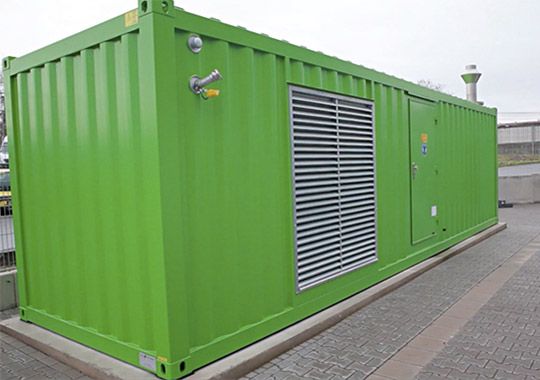
Related
topics:
classic
Ups
For the reliable operation of a data center a Uninterrupted Power supply system is absolutely necessary, but which type will be the right one?... more
Power supply
Combined Heat and Power Unit (CHP)
Combined Heat and Power Units (CHP) reduce operating costs for electricity and heat considerably... more
We'll take
care of IT!

classic
Emergency power system
Irregularities in power supply, such as voltage fluctuations or short failures can be bridged via uninterrupted power supply unit. However, to continure operating a high availability data center during longer power failures, a self-sufficient possibility for power generation. An emergency power system doesn’t have to be able to start up within seconds, since an uninterrupted power supply unit covers short-term failures, but should be able to provide required power performance over a long period of time.
The different kinds of emergency power systems vary in regard to the energy source with which the power is generated. The conventional emergency power system is a generator, which is operated by fossil fuels, such as diesel or gas.
Alternative sources of energy can also be renewable raw materials, such as vegetable oils or biogas, for the operation of a block-type thermal power station. The advantage of such a block-type thermal power station is that during continuous operation it can be used as a thrifty and environmentally friendly electricity source during and if necessary, can be used only to provide power for the data center. If using a block-type thermal power station in continuous operation, it must be available redundantly in order to
The different kinds of emergency power systems vary in regard to the energy source with which the power is generated. The conventional emergency power system is a generator, which is operated by fossil fuels, such as diesel or gas.
Alternative sources of energy can also be renewable raw materials, such as vegetable oils or biogas, for the operation of a block-type thermal power station. The advantage of such a block-type thermal power station is that during continuous operation it can be used as a thrifty and environmentally friendly electricity source during and if necessary, can be used only to provide power for the data center. If using a block-type thermal power station in continuous operation, it must be available redundantly in order to
ensure availability as a emergency power system, even during maintenance.
Another source of energy is the use of hydrogen. This can be converted into electricity through a hydrogen fuel cell. This technology is ecologically absolutely uncritical and low-maintenance. It can be arranged, for the hydrogen to be won out of solar energy and rain water, creating an eternal loop. In comparison with other emergency power systems no constant supply of the fuel would be necessary.
During power failures the emergency power system is activated automatically through monitoring systems. This regulation-unit is placed in the sub-distribution and the control of the aggregate. The size and capacity of the emergency power system can be matched to the respective data center. When planning for an emergency power system it should be considered that other areas outside the data center might be in need for emergency power supply too and should be considered when planning size an capacity.
Another source of energy is the use of hydrogen. This can be converted into electricity through a hydrogen fuel cell. This technology is ecologically absolutely uncritical and low-maintenance. It can be arranged, for the hydrogen to be won out of solar energy and rain water, creating an eternal loop. In comparison with other emergency power systems no constant supply of the fuel would be necessary.
During power failures the emergency power system is activated automatically through monitoring systems. This regulation-unit is placed in the sub-distribution and the control of the aggregate. The size and capacity of the emergency power system can be matched to the respective data center. When planning for an emergency power system it should be considered that other areas outside the data center might be in need for emergency power supply too and should be considered when planning size an capacity.
It is also important to run Regular overload tests, as neutral test runs do not always show existing problems. Test runs should be carried out every four weeks to assure that the system starts flawlessly in case of emergency.
The emergency power system can be installed within a room of a building, but also outside for example within a container. Furthermore there are small encapsulated systems which can serve as mobile bridging solutions while constructions are made.
we will find the best emergency power system for you. Don’t hesitate to ask us, we’ll take care of IT.
innovIT - CARES ABOUT IT
The emergency power system can be installed within a room of a building, but also outside for example within a container. Furthermore there are small encapsulated systems which can serve as mobile bridging solutions while constructions are made.
we will find the best emergency power system for you. Don’t hesitate to ask us, we’ll take care of IT.
innovIT - CARES ABOUT IT


